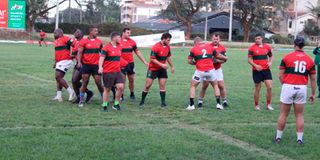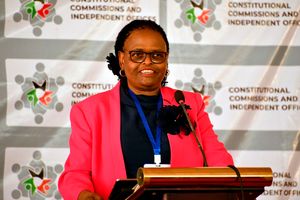Currie Cup: World’s oldest provincial rugby tournament comes to Kenya

South African side North West Leopards training at Rugby Football Union East Africa ground in Nairobi on June 3, 2022 on the eve of their Currie Cup clash against Kenya Simbas at the same venue.
What you need to know:
- Many great South African players have shown their class and influence right here on Kenyan soil
- History beckons when, for the first time, a Currie Cup fixture will be staged in Kenya but the links between East African and South African rugby run far and deep. South Africa’s fabled Springboks once played in Nairobi, the only time they have competitively engaged in Africa outside their motherland, while many teams from the Rainbow Nation toured Kenya and helped in the growth of the game through skill and player transfer
April 9 was a historic day when the Kenya national rugby team played in their first ever Currie Cup match.
Kenya Simbas took on the Valke Falcons at the Bosman Stadium in Brakpan, South Africa losing 51-14.
Saturday will be another historic day in Kenyan and East African rugby when a Currie Cup fixture is held in the country for the very first time in history.
Two of the league’s First Division fixture will be played, fittingly, at the hallowed turf of East African rugby, Rugby Football Union of East Africa ground in Nairobi.
Kenya Simbas take on league defending champions North West Leopards on Saturday and Eastern Province next Saturday.
But what is the Currie Cup?
The Currie Cup is the oldest provincial rugby competition in the world that was first
played in 1892.
It is the backbone of South Africa’s and Springbok’s rugby.
According to the definitive history book “The History of the
British & Irish Lions” by Thomas Clem, one Sir Donald Currie donated the Cup and gave it to the British Lions on their inaugural tour of South Africa in 1891.He asked that they present it to the best provincial side. And that is how the tournament came to being.
However, today will not be the first time that a fixture of the league is being
played outside South Africa.
A passage in the “Zimbabwe Rugby Centenary 1895-1995” by Jonty Winch, reads: “Rhodesia played in the Currie Cup starting in 1898 in South Africa. However, it
was not until 1946 that a Currie Cup match was played at the Hartsfield Grounds
in Bulawayo where the hosts Rhodesia lost 3-8 to Transvaal. Rhodesia played in
the competition on a home and away basis up to 1980. Zimbabwe played five
Currie Cup matches at home in 1980. Four of the games were played in Salisbury-
(now Harare) and one in Bulawayo all lost.”
The Currie Cup fixtures in Kenya should not really be a surprise.
Kenya and East Africa rugby has been linked to South African rugby from the
early days. The Rugby Football Union of Kenya (RFUK), the umbrella administrative
body for Kenya, Uganda and Tanganyika, formed on August 1, 1921 was affiliated to the South African Rugby Board in 1925.The Kenya Rugby Referees Society formed
in 1927 was affiliated to the South African Rugby Referees Society.
Touring teams from South Africa helped in the growth of the game in East Africa.
The following sides toured the region in the early parts of the last century: The Combined South African Universities in 1929 and 1930, Stellenbosch University in 1935, the University of Cape Town in 1949 and 1950, a Combined Stellenbosch University and University of Cape Town side in 1955 and Rhodes University in 1956.
Others are: University of Cape Town Invitational XVs in 1958 and1959, Pretoria
Harlequins in 1961 and South Africa’s Springboks in February 1961.
To date Kenya is the only African country outside South Africa where the Springboks have played.
The links between East Africa and South Africa rugby were further strengthened
by the great trek that brought the Afrikaners to the Uasin Gishu Plateau, Thomsons Falls area and Arusha-Moshi in Tanzania.
Eldoret RFC made up
Predominantly of Boers and Afrikaners, went on to dominate the Enterprise Cup
the Holy Grail of East African rugby, winning five titles on the trot from 1932 to 1936 and also in 1939 and 1947.
Chris Young and Robert Balfour-Laing, who played in the 1956 Currie Cup final for Natal Province in their 8-9 loss to Northern Transvaal at Kings Park, Durban are notable for the following reasons.
Young relocated to Kenya and went on to lift the Enterprise Cup with Nakuru RFC in 1960, 1962 and 1963 while Balfour-Laing lifted the Cup featuring for Kenya Harlequin in1964.
In 1964, they played on opposite sides in the Cup final at Nakuru Athletics Club.
Balfour-Laing was born in Springs, South Africa on 26 April 1933 and first picked up rugby at School in Southern Rhodesia (now Zimbabwe) at Rhodes Estate Preparatory Primary School near Bulawayo then Plumtree School.
He was first selected for the Southern Rhodesian School side which toured Natal,
South Africa in 1951.
This was followed by a stint at University of Natal and representation at both local
and provincial rugby.
Before moving to Kenya, Balfour-Laing had played for Central Universities and Natal against the 1955 British and Irish Lions in South Africa.
Balfour-Laing played for Natal in the 1956 Currie Cup final lose to Northern Transvaal.
He was a 1958 Springbok trialist.
He arrived in Kenya in June 1961 and quickly became established in the Kenya
Harlequins team. He went on to play for the Kenya Central Province RFU and Kenya.
“Laing had pace, power, vision and swivel.” Nick Paterson, his 1962 Tuskers colleague, described him to this writer in a 2018 interview.
Balfour-Laing played for East Africa and the Tuskers, as flanker or number eight.
He was an outstanding athlete and footballer, playing with equal facility as either blind-side or open-side flanker or number eight. To this gentleman went the singular honour of captaining the very first East African team to play for the newly independent Kenya, Uganda and Tanzania, in a Test match fresh from winning the Five Nation Wales on May 12, 1964.
Balfour–Laing was in the Quins team that won the Enterprise Cup in 1964, beating Nakuru 23-12 at the Nakuru Athletics Club.
“Balfour–Laing one of the best players in the country” as he was described by a pundit in the Daily Nation announced his retirement at the end of 1964 after winning the Enterprise Cup’ with Quins.
He returned to South Africa in 1970 where he passed away on March 18, 2019.
“Chris C. Young was the finest player to perform for East Africa in my esteemed
opinion,” so said Simon David ‘Lofty’ Reynolds his Nakuru, Kenya, Scorpions, West Kenya and Tuskers colleague.
Young, then 29, was a revelation when he first appeared for the West Kenya team against the Central Province team in the 1959 Inter-Provincial final.
Young lifted his first Enterprise Cup in 1960 against Impala in Nakuru, scoring
a try and kicking a conversion.
He captained the East African XVs against South Africa’s Springboks on February 25, 1961 and against the British Lions on August 28 1962.
Both matches were played at a sold out RFUEA ground.
He was influential in Rift Valley 12-3 win over Nairobi powerhouse side, Nondescripts in the 1962 Enterprise Cup final.
He was at it again in the 1963 Enterprise Cup final leading a 14-man Nakuru
to a 17-9 victory over Impala.
Young also played cricket for Kenya.
Young and Balfour-Laing both skippered the Kenya Simbas. Young in 1961 and Balfour-Laing in 1964.
Who will win today’s monumental fixture at RFUEA ground that has echoes of a glorious past in Kenyan rugby?
See you all at the ground Saturday afternoon.
Okong’o is an East African rugby historian




